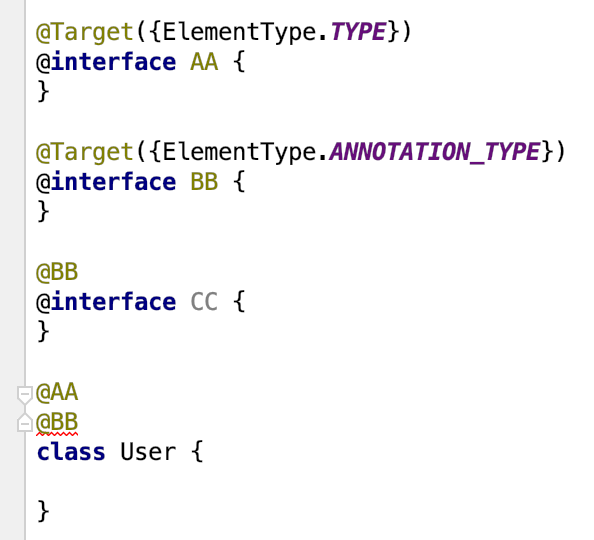Java 元注解及 Spring 组合注解应用
Java 1.5(Tiger) 个人认为最为激动人心的两个特性是泛型与注解(Java Versions, Features and History)。泛型自然是不必说了,注解对 Java 世界的改变比泛型伟大的多(现在框架的注解配置),在 Java 1.5 之前我们只能在 Javadoc 注释中做文章,于是只能用 XDoclet 那样不伦不类的东西。Java 的注解发展到现在几乎可以使用在书写代码时的任何地方,见 java.lang.annotation.ElementType 中的类型,囊括了 TYPE, FIELD, METHOD, PARAMETER, CONSTRUCTOR, LOCAL_VARIABLE, ANNOTATION_TYPE, PACKAGE, TYPE_PARAMETER(since 1.8), TYPE_USE(since 1.8)。
Java 1.5 基本确定了注解的基本框架,包括元注解(meta-annotation); 直到 Java 8 又扩展了注解的使用范围,列举如下:
创建类实例
new@Interned MyObject();
类型映射
myString = (@NonNull String) str;
implements 语句中
class UnmodifiableList<T> implements@Readonly List<@Readonly T> { ... }
throw exception声明
void monitorTemperature() throws@Critical TemperatureException { ... }
解析前面 ElementType Java 8 增加的 TYPE_PARAMETER和 TYPE_USE 注解使用新场合。ElementType.TYPE_PARAMETER 表示该注解能写在类型变量的声明语句中。ElementType.TYPE_USE 表示该注解能写在使用类型的任何语句中(如: 声明语句、泛型和强制转换语句中的类型)
另外就是更方便使用的重复注解 -- @Repeatable
本文不会讲解 Java 注解的基本知识和创建自定的注解,主要关注标题中的 Java 元注解及 Spring 对元注解的广泛应用 -- 即 Spring 组合注解
Java 元注解(meta-annotation)
所谓的元注解(meta-annotation) 也就是注解的注解,注解本身就是元数据,像 meta-data。具体到 Java 的注解就是注解可以应用到别的注解上去,@Target 包含了 ANNOTATION_TYPE。所以在我们定义普通注解时用到的 @Retention, @Target, @Documented, @Inherited, @Repeatable 就是一拨 Java 内置元注解,下面是 @Target 的定义
1@Documented
2@Retention(RetentionPolicy.RUNTIME)
3@Target(ElementType.ANNOTATION_TYPE)
4public @interface Retention {
5 RetentionPolicy value();
6}体验一下 @Inherited 注解的作用
@Inherited 标明注解是能够被传递到子类的,即注解在父类的注解也会作用到它的子类上去,比如 Spring 的 @Transactional 注解就被 @Inherited 标识了
1@Target({ElementType.METHOD, ElementType.TYPE})
2@Retention(RetentionPolicy.RUNTIME)
3@Inherited
4@Documented
5public @interface Transactional {
6 ......
7}具体表现就是
1@Transactional
2public class BaseRepository {
3 ......
4}
5
6public class UserRepository extends BaseRepository {
7 ......
8}UserRepository 继承了 BaseRepository, 所以 UserRepository 也就启用了事物。
自己来一下
1@Target({ElementType.TYPE})
2@Retention(RetentionPolicy.RUNTIME)
3@Inherited
4@interface BB {
5}
6
7@BB
8class Parent {
9}
10
11class Child extends Parent {
12}
13
14public class Test {
15 public static void main(String[] args) {
16 BB bb = Child.class.getAnnotation(BB.class);
17 System.out.println(bb); //BB 注解没有 @Inherited 的话,bb 将为 null
18 }
19}在注解中如果去掉 @Inherited, 上面的 Child.class.getAnnotation(BB.class) 将返回 null.
要是换成实现一个接口,事情就不一样了
1@BB
2interface Parent {
3}
4
5class Child implements Parent {
6}
7
8//Child.class.getAnnotation(BB.class) 总是为 null 值Child 不管是在 @BB 有没有 @Inherited 标识都继承不到 @BB 注解。
@Target({ElementType.ANNOTATION_TYPE})
ElementType.ANNOTATION_TYPE 的用处,好像也就是一个约束,只限定被它声明了注解只能用于其他的注解类型上去,看下面的图片

User 类上的 @BB 处报错: '@BB' not applicable to type. 就是说 @Target 为 ElementType.ANNOTATION_TYPE 的注解只能用于其他注解上,而 @Target 为 ElementType.TYPE 可以用在许多地方,类,接口,枚举或其他注解上。除此之外,ElementType.ANNOTATION_TYPE 也没别的太多意思,它与下面的组合注解没有什么关系。
Spring 中的元注解与组合注解
再重新回味一下,Java 原生的元注解(Meta-annotations) 基本就是指内置的 @Retention, @Target, @Documented, @Inherited, @Repeatable 那一干注解,以及自定义注解加上 @Target({ElementType.ANNOTATION_TYPE}) 实现的自定义元注解。而 Spring 的元注解概念是不一样的,它认为能用于注解的注解就是元注解,即 @Target({ElementType.Type}) 标识的也是元注解,因为其他的注解也是 Type.
Spring 中元注解与组合注解又是很紧密的两个概念,从官方的文档中
1@Target({ElementType.TYPE})
2@Retention(RetentionPolicy.RUNTIME)
3@Documented
4@Component
5public @interface Service {
6 String value() default "";
7}由于 @Component 注解到了 @Service 注解,所以这里的 @Component 称之元注解,而 @Service 而称之为组合注解,即组合了 @Component 的注解,当然还能组合更多的元注解。在 Spring 中有大量组合注解的例子,像 @GetMapping
1@Target({ElementType.METHOD})
2@Retention(RetentionPolicy.RUNTIME)
3@Documented
4@RequestMapping( //这里的 @RequestMapping 就是 @GetMapping 的元注解
5 method = {RequestMethod.GET}
6)
7public @interface GetMapping {
8 ....
9}为什么说 @Component 和 @RequestMapping 不是一般意义上 Java 的元注解呢,只要查看下 @Component 的定义就知道,
1@Target({ElementType.TYPE}) //它的 Target 并不需要有 ElementType.ANNOTATION_TYPE, 这不并妨碍它应用于别的注解上
2@Retention(RetentionPolicy.RUNTIME)
3@Documented
4public @interface Component {
5 String value() default "";
6}创建自己的组合注解
比如想要声明一个 Lazy 的 Bean,在 JavaConfig 方法上要同时用到两个注解 @Lazy 和 @Bean
1@Lazy
2@Bean(name = "newName")
3public String testLazyBean() {
4 return "hello world";
5}那么我们是否能创建一个组合注解,只用一个注解就能声明出一个 Lazy 的 Bean 来呢,没问题,就是下面的 @LazyBean
1@Target({ElementType.METHOD})
2@Retention(RetentionPolicy.RUNTIME)
3@Bean
4@Lazy
5public @interface LazyBean {
6
7 @AliasFor(annotation = Bean.class, attribute = "value")
8 String[] name() default {};
9}然后前面的声明 Bean 的代码就能够写成
1@LazyBean(name = "newName")
2public String testLazyBean() {
3 return "hello world";
4}节约了一行代码,简洁明了,表现力也增强了。如果需要组合更多的元注解时,代码效果上就会更佳了。
从 Spring 组合注解的结果推导出它的内部实现,被 @LazyBean 标的 bean, 相当于同时被 @Bean 和 @Lazy 标注了。
借机加强理解一下 Spring 中元注解与组合注解的概念:
- 这儿的 @Bean 和 @Lazy 是用来注解 @LazyBean 的,所以 @Bean 和 @Lazy 称之为元注解
- @LazyBean 是由 @Bean 和 @Lazy 组合而成的,因此 @LazyBean 就是一个组合注解
Spring 的组合注解是如何工作的
如果使用正常的 Java 注解反射 API getAnnotation() 和 isAnnotationPresent() 只能发现组合后的注解 @LazyBean, 而元注解是这样得不到的。但 Spring 在发现注解的时候走入的更深,注解的注解(元注解)和组合后的注解都能捞出来。看下面的例子
1@Retention(RetentionPolicy.RUNTIME)
2@Target({ElementType.TYPE})
3@interface AA {
4}
5
6@Retention(RetentionPolicy.RUNTIME)
7@Target({ElementType.TYPE})
8@interface BB {
9}
10
11@Retention(RetentionPolicy.RUNTIME)
12@AA
13@BB
14@interface CC {
15}
16
17@CC
18class User {
19}
20
21public class Test {
22 public static void main(String[] args) {
23 User.class.getAnnotation(CC.class); // @yanbin.blog.CC()
24 User.class.getAnnotation(AA.class); // null
25 User.class.getAnnotation(BB.class); // null
26
27 User.class.isAnnotationPresent(CC.class); //true
28 User.class.isAnnotationPresent(AA.class); //false
29 User.class.isAnnotationPresent(BB.class); //false
30 }
31}上面的 @CC 由 @AA 和 @BB 组合而成,用 @CC 注解到 User 类上,常规的 Java 反射类只能找到 @CC,要反射出 @AA 和 @BB,必须对 @CC 类进一步反射。而 Spring 提供了 AnnotationUtils 和 AnnotatedElementUtils 工具类来查找注解类,如下
1AnnotationUtils.findAnnotation(User.class, CC.class); // @yanbin.blog.CC()
2AnnotationUtils.findAnnotation(User.class, AA.class); // @yanbin.blog.AA()
3AnnotationUtils.findAnnotation(User.class, BB.class); // @yanbin.blog.BB()
4
5AnnotationUtils.isAnnotationMetaPresent(CC.class, AA.class); // true
6AnnotationUtils.isAnnotationMetaPresent(CC.class, BB.class); // true
7
8AnnotatedElementUtils.getMergedAnnotation(User.class, CC.class); // @yanbin.blog.CC()
9AnnotatedElementUtils.getMergedAnnotation(User.class, AA.class); // @yanbin.blog.AA()
10AnnotatedElementUtils.getMergedAnnotation(User.class, BB.class); // @yanbin.blog.BB()
11
12AnnotatedElementUtils.findMergedAnnotation(User.class, CC.class); // @yanbin.blog.CC()
13AnnotatedElementUtils.findMergedAnnotation(User.class, AA.class); // @yanbin.blog.AA()
14AnnotatedElementUtils.findMergedAnnotation(User.class, BB.class); // @yanbin.blog.BB()如某个类(User) 被某个组合注解(@CC) 修饰了,Spring 认该类(User) 被组成 @CC 的所有元注解(@AA 和 @BB) 修饰了。
组合注解时的属性值传递与覆盖
如果组合注解的元注解有属性值时,直接写就行了,例如:
1@Target({ElementType.METHOD})
2@Retention(RetentionPolicy.RUNTIME)
3@Bean("FixedLazyBean")
4@Lazy
5public @interface LazyBean {
6}用上面的组合注解 @LazyBean 标注到某个方法上,注册 SpringBean 时的名称就是 @Bean("FixedLazyBean") 中的 "FixedLazyBean"。
假如在使用 @LazyBean 注解时还要能够动态指定 Spring bean 名称,那么 @LazyBean 中就需要一个属性覆盖 @Bean 的 value 属性(或者说传递给 @Bean 的 value 属性),这时修又要用到一个 Spring 特定的注解 @AliasFor -- Spring 4.2 新加的特性(New Features and Enhancements in Spring Framework 4.2)。对合并属性的获得也是用 AnnotatedElementUtils 中的方法 findMergedAnnotationAttributes(...), 还是看例子:
1@Target({ElementType.METHOD, ElementType.ANNOTATION_TYPE})
2@Retention(RetentionPolicy.RUNTIME)
3@Bean
4@Lazy
5public @interface LazyBean {
6
7 @AliasFor(annotation = Bean.class, attribute = "name")
8 String[] name() default {}; //@LazyBean 的 name 值传递给元注解 @Bean 的 name 属性
9}应用 @LazyBean 时指定 Bean name
1@LazyBean(name = "newName")
2public String testLazyBean() {
3 return "hello";
4}这样就会向 Spring 上下文中注册一个名称为 "newName" 的字符串。
Spring 的 @AliasFor 使用时有不少要求,请参见它的 Javadoc 文档 Annotation Type AliasFor. 创建一个组合注解后最好在使用之前测试它是否完全达到预期,尤其是在覆盖注解的 value 属性时要多加留意。
链接:
- Java 8 新特性:扩展注解(类型注解和重复注解)
- 1.10.2. Using Meta-annotations and Composed Annotations
- Implementing custom annotations for Spring MVC
- Spring Annotation Programming Model
- Spring 4 Meta Annotations
[版权声明]
 本文采用 署名-非商业性使用-相同方式共享 4.0 国际 (CC BY-NC-SA 4.0) 进行许可。
本文采用 署名-非商业性使用-相同方式共享 4.0 国际 (CC BY-NC-SA 4.0) 进行许可。